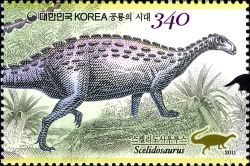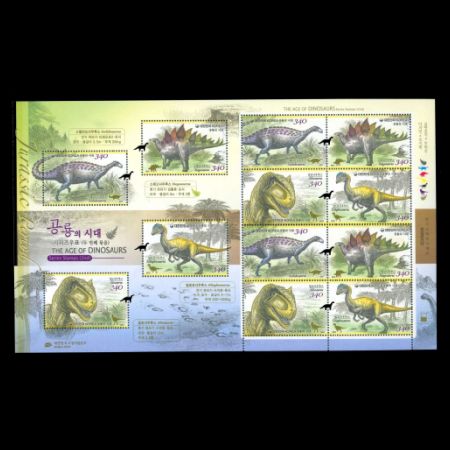South Korea 2011 "The Age of Dinosaurs - Jurassic Period"
| <prev | back to index | next> |
| Issue Date | 11.08.2011 |
| ID | Michel: 2831-2834; Scott: 2364a-d; Stanley Gibbons: 3166-3169; Yvert et Tellier: 2625-2628; Category: pR |
| Design | Designer - Jiwon MO; Engraver- Yeongsook HEO |
| Stamps in set | 4 |
| Value |
Won 340 - Scelidosaurus Won 340 - Stegosaurus Won 340 - Allosaurus Won 340 - Dilophosaurus |
| Emission/Type | commemorative |
| Issue place | Seoul |
| Size (width x height) | stamps: 50mm X 33mm, Sheet: 250mm x 150mm |
| Layout | Sheet of 12 stamps |
| Products | FDC x1 |
| Paper | White Unwatermarked |
| Perforation | 13 |
| Print Technique | Offset, six colors + Intaglio, one color |
| Printed by | Korea Minting and Security Printing Corporation |
| Quantity | 540,000 stamps each |
| Issuing Authority | Korea Post |

On August 11th 2011, Korean Post issued the second set "The Age of Dinosaurs" of the three-year series, started in 2010. This series covers Mesozoic Era and features dinosaurs found around the world. Every issue show four dinosaurs and cover one period of the Mesozoic Era:
- "Triassic Period" - 05.08.2010
- "Jurassic Period" - 11.08.2011
- "Cretaceous Period" - 08.08.2012
"The Age of Dinosaurs (1st)" was issued in 2010, Jurassic dinosaurs of the Mesozoic Era are introduced in the second set.
The Jurassic Period of the Mesozoic Era spanned 50 million years from 199.6 to 145.5 million years ago. It is the second period of the Mesozoic Era following the Triassic Period. In this period, giant reptiles such as dinosaurs thrived on the land, and ammonites, in the sea. In the latter part of the Jurassic Period, birds appeared for the first time, with gymnosperms like cycads and gingkoes thriving.
 |
| Scelidosaurus dinosaur on stamp of South Korea 2011, MiNr.: 2831, Scott: 2364a. |
 |
| Stegosaurus dinosaur on stamp of South Korea 2010, MiNr.: 2832, Scott: 2364b. |
Stegosaurus as an herbivorous dinosaur during the Late Jurassic spikes on its tails. Compared to its large body, its head was relatively very small, with its long hind legs and short, crooked front legs making its back crook forward. With its large body, it moved very sluggishly. It is 9 m in height and 2 tons in weight. It was discovered in the western part of the U.S.A.
 |
| Allosaurus dinosaur on stamp of South Korea 2011, MiNr.: 2833, Scott: 2364c. |
 |
| Dilophosaurus dinosaur on stamp of South Korea 2010, MiNr.: 2834, Scott: 2364d. |
Dilophosaurus as a carnivorous dinosaur during the Early Jurassic, it had two crests split in the shape of a V on top of its head. Its razor-sharp teeth, long and strong legs, and long claws were perfect for hunting. Its first toe on its hand was shaped in the way to hold a prey, functioning like a thumb. It was 330~450 kg in weight, and 6~7 m in height. It was first reported in the U.S.A., with the possibility of having been discovered in the southern part of China being raised.
Products and associated philatelic items
| FDC | First-Day-of-Issue Postmark | |
 |
 |
 |
| The reverse side of the FDC contains technical details about the issue. | ||
| Mini-Sheet | Boklet | |
 |
 |
|
| Example of circulated covers | ||
 |
 |
 |
References:

|
- Technical details and short press releases:
Korean stamp postal services, colnect.
Acknowledgements:
- Many thanks to Dr. Peter Voice from Department of Geological and Environmental Sciences, Western Michigan University, for review of a draft of this article.
| <prev | back to index | next> |